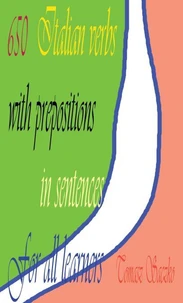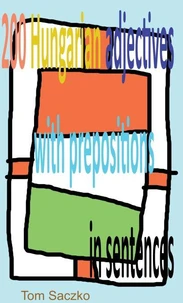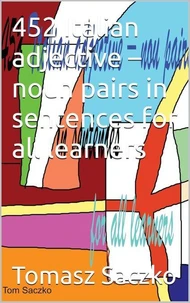Spanish tenses for all learners
Par :Formats :
Disponible dans votre compte client Decitre ou Furet du Nord dès validation de votre commande. Le format ePub est :
- Compatible avec une lecture sur My Vivlio (smartphone, tablette, ordinateur)
- Compatible avec une lecture sur liseuses Vivlio
- Pour les liseuses autres que Vivlio, vous devez utiliser le logiciel Adobe Digital Edition. Non compatible avec la lecture sur les liseuses Kindle, Remarkable et Sony
 , qui est-ce ?
, qui est-ce ?Notre partenaire de plateforme de lecture numérique où vous retrouverez l'ensemble de vos ebooks gratuitement
Pour en savoir plus sur nos ebooks, consultez notre aide en ligne ici
- FormatePub
- ISBN8231822119
- EAN9798231822119
- Date de parution22/05/2025
- Protection num.pas de protection
- Infos supplémentairesepub
- ÉditeurWalzone Press
Résumé
Mastering Spanish verb tenses is one of the most crucial steps in achieving fluency in the Spanish language. For many English speakers, the complexity and variety of Spanish tenses can seem overwhelming at first glance. Where English relies heavily on auxiliary verbs and simple structures, Spanish employs a rich system of conjugations that can express subtle differences in time, mood, and aspect with remarkable precision.
This book is designed to demystify Spanish tenses and provide you with a clear, systematic approach to understanding and using them correctly. Whether you're a beginner taking your first steps into Spanish grammar or an intermediate learner looking to refine your understanding, this comprehensive guide will serve as your roadmap through the intricate landscape of Spanish verbal expression. Why Spanish Tenses MatterSpanish tenses do more than simply indicate when an action occurs.
They convey the speaker's attitude toward the action, whether it's completed or ongoing, certain or hypothetical, and how it relates to other events in time. A single verb can be conjugated in dozens of different ways, each carrying its own specific meaning and emotional weight. Understanding these nuances is essential for effective communication and for truly appreciating the beauty of the Spanish language.
Consider the difference between "Comí" (I ate) and "Comía" (I was eating/used to eat). Both refer to past actions, but they paint entirely different pictures of how those actions unfolded. The first suggests a completed action, while the second implies an ongoing or habitual past action. These distinctions, multiplied across all Spanish tenses, create a linguistic system of extraordinary expressiveness.
What You'll Find in This BookThis book takes a practical, step-by-step approach to Spanish tenses. We begin with the most fundamental present tense forms and gradually build complexity, ensuring that each new concept builds naturally upon previously learned material. Each tense is presented with clear explanations of its formation, comprehensive usage rules, and abundant examples drawn from everyday Spanish conversation.
You'll discover not just how to form each tense, but when and why to use it. We explore the subtle differences between similar tenses, common mistakes to avoid, and regional variations that might affect your understanding. Special attention is given to the subjunctive mood, often considered the most challenging aspect of Spanish grammar for English speakers. Throughout the book, you'll find practical exercises, memory aids, and real-world examples that will help solidify your understanding.
We've also included cultural notes that explain how different Spanish-speaking regions might favor certain constructions over others, giving you a more complete picture of how Spanish is actually spoken across the globe. Your Journey AheadLearning Spanish tenses is not about memorizing endless conjugation tables, though some memorization is certainly necessary. It's about developing an intuitive sense of how Spanish speakers think about time, certainty, and relationships between events.
As you progress through this book, you'll begin to internalize these patterns and develop the confidence to express yourself with the precision and elegance that makes Spanish such a beautiful language. Remember that mastering Spanish tenses is a gradual process. Be patient with yourself, practice regularly, and don't be afraid to make mistakes-they're an essential part of the learning journey. With dedication and the guidance provided in these pages, you'll soon find yourself navigating Spanish tenses with confidence and skill.¡Empecemos! Let's begin!
This book is designed to demystify Spanish tenses and provide you with a clear, systematic approach to understanding and using them correctly. Whether you're a beginner taking your first steps into Spanish grammar or an intermediate learner looking to refine your understanding, this comprehensive guide will serve as your roadmap through the intricate landscape of Spanish verbal expression. Why Spanish Tenses MatterSpanish tenses do more than simply indicate when an action occurs.
They convey the speaker's attitude toward the action, whether it's completed or ongoing, certain or hypothetical, and how it relates to other events in time. A single verb can be conjugated in dozens of different ways, each carrying its own specific meaning and emotional weight. Understanding these nuances is essential for effective communication and for truly appreciating the beauty of the Spanish language.
Consider the difference between "Comí" (I ate) and "Comía" (I was eating/used to eat). Both refer to past actions, but they paint entirely different pictures of how those actions unfolded. The first suggests a completed action, while the second implies an ongoing or habitual past action. These distinctions, multiplied across all Spanish tenses, create a linguistic system of extraordinary expressiveness.
What You'll Find in This BookThis book takes a practical, step-by-step approach to Spanish tenses. We begin with the most fundamental present tense forms and gradually build complexity, ensuring that each new concept builds naturally upon previously learned material. Each tense is presented with clear explanations of its formation, comprehensive usage rules, and abundant examples drawn from everyday Spanish conversation.
You'll discover not just how to form each tense, but when and why to use it. We explore the subtle differences between similar tenses, common mistakes to avoid, and regional variations that might affect your understanding. Special attention is given to the subjunctive mood, often considered the most challenging aspect of Spanish grammar for English speakers. Throughout the book, you'll find practical exercises, memory aids, and real-world examples that will help solidify your understanding.
We've also included cultural notes that explain how different Spanish-speaking regions might favor certain constructions over others, giving you a more complete picture of how Spanish is actually spoken across the globe. Your Journey AheadLearning Spanish tenses is not about memorizing endless conjugation tables, though some memorization is certainly necessary. It's about developing an intuitive sense of how Spanish speakers think about time, certainty, and relationships between events.
As you progress through this book, you'll begin to internalize these patterns and develop the confidence to express yourself with the precision and elegance that makes Spanish such a beautiful language. Remember that mastering Spanish tenses is a gradual process. Be patient with yourself, practice regularly, and don't be afraid to make mistakes-they're an essential part of the learning journey. With dedication and the guidance provided in these pages, you'll soon find yourself navigating Spanish tenses with confidence and skill.¡Empecemos! Let's begin!
Mastering Spanish verb tenses is one of the most crucial steps in achieving fluency in the Spanish language. For many English speakers, the complexity and variety of Spanish tenses can seem overwhelming at first glance. Where English relies heavily on auxiliary verbs and simple structures, Spanish employs a rich system of conjugations that can express subtle differences in time, mood, and aspect with remarkable precision.
This book is designed to demystify Spanish tenses and provide you with a clear, systematic approach to understanding and using them correctly. Whether you're a beginner taking your first steps into Spanish grammar or an intermediate learner looking to refine your understanding, this comprehensive guide will serve as your roadmap through the intricate landscape of Spanish verbal expression. Why Spanish Tenses MatterSpanish tenses do more than simply indicate when an action occurs.
They convey the speaker's attitude toward the action, whether it's completed or ongoing, certain or hypothetical, and how it relates to other events in time. A single verb can be conjugated in dozens of different ways, each carrying its own specific meaning and emotional weight. Understanding these nuances is essential for effective communication and for truly appreciating the beauty of the Spanish language.
Consider the difference between "Comí" (I ate) and "Comía" (I was eating/used to eat). Both refer to past actions, but they paint entirely different pictures of how those actions unfolded. The first suggests a completed action, while the second implies an ongoing or habitual past action. These distinctions, multiplied across all Spanish tenses, create a linguistic system of extraordinary expressiveness.
What You'll Find in This BookThis book takes a practical, step-by-step approach to Spanish tenses. We begin with the most fundamental present tense forms and gradually build complexity, ensuring that each new concept builds naturally upon previously learned material. Each tense is presented with clear explanations of its formation, comprehensive usage rules, and abundant examples drawn from everyday Spanish conversation.
You'll discover not just how to form each tense, but when and why to use it. We explore the subtle differences between similar tenses, common mistakes to avoid, and regional variations that might affect your understanding. Special attention is given to the subjunctive mood, often considered the most challenging aspect of Spanish grammar for English speakers. Throughout the book, you'll find practical exercises, memory aids, and real-world examples that will help solidify your understanding.
We've also included cultural notes that explain how different Spanish-speaking regions might favor certain constructions over others, giving you a more complete picture of how Spanish is actually spoken across the globe. Your Journey AheadLearning Spanish tenses is not about memorizing endless conjugation tables, though some memorization is certainly necessary. It's about developing an intuitive sense of how Spanish speakers think about time, certainty, and relationships between events.
As you progress through this book, you'll begin to internalize these patterns and develop the confidence to express yourself with the precision and elegance that makes Spanish such a beautiful language. Remember that mastering Spanish tenses is a gradual process. Be patient with yourself, practice regularly, and don't be afraid to make mistakes-they're an essential part of the learning journey. With dedication and the guidance provided in these pages, you'll soon find yourself navigating Spanish tenses with confidence and skill.¡Empecemos! Let's begin!
This book is designed to demystify Spanish tenses and provide you with a clear, systematic approach to understanding and using them correctly. Whether you're a beginner taking your first steps into Spanish grammar or an intermediate learner looking to refine your understanding, this comprehensive guide will serve as your roadmap through the intricate landscape of Spanish verbal expression. Why Spanish Tenses MatterSpanish tenses do more than simply indicate when an action occurs.
They convey the speaker's attitude toward the action, whether it's completed or ongoing, certain or hypothetical, and how it relates to other events in time. A single verb can be conjugated in dozens of different ways, each carrying its own specific meaning and emotional weight. Understanding these nuances is essential for effective communication and for truly appreciating the beauty of the Spanish language.
Consider the difference between "Comí" (I ate) and "Comía" (I was eating/used to eat). Both refer to past actions, but they paint entirely different pictures of how those actions unfolded. The first suggests a completed action, while the second implies an ongoing or habitual past action. These distinctions, multiplied across all Spanish tenses, create a linguistic system of extraordinary expressiveness.
What You'll Find in This BookThis book takes a practical, step-by-step approach to Spanish tenses. We begin with the most fundamental present tense forms and gradually build complexity, ensuring that each new concept builds naturally upon previously learned material. Each tense is presented with clear explanations of its formation, comprehensive usage rules, and abundant examples drawn from everyday Spanish conversation.
You'll discover not just how to form each tense, but when and why to use it. We explore the subtle differences between similar tenses, common mistakes to avoid, and regional variations that might affect your understanding. Special attention is given to the subjunctive mood, often considered the most challenging aspect of Spanish grammar for English speakers. Throughout the book, you'll find practical exercises, memory aids, and real-world examples that will help solidify your understanding.
We've also included cultural notes that explain how different Spanish-speaking regions might favor certain constructions over others, giving you a more complete picture of how Spanish is actually spoken across the globe. Your Journey AheadLearning Spanish tenses is not about memorizing endless conjugation tables, though some memorization is certainly necessary. It's about developing an intuitive sense of how Spanish speakers think about time, certainty, and relationships between events.
As you progress through this book, you'll begin to internalize these patterns and develop the confidence to express yourself with the precision and elegance that makes Spanish such a beautiful language. Remember that mastering Spanish tenses is a gradual process. Be patient with yourself, practice regularly, and don't be afraid to make mistakes-they're an essential part of the learning journey. With dedication and the guidance provided in these pages, you'll soon find yourself navigating Spanish tenses with confidence and skill.¡Empecemos! Let's begin!























